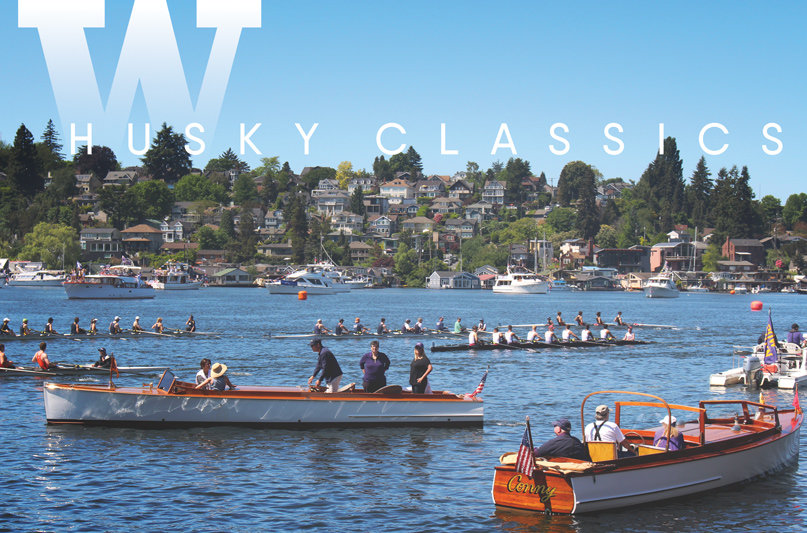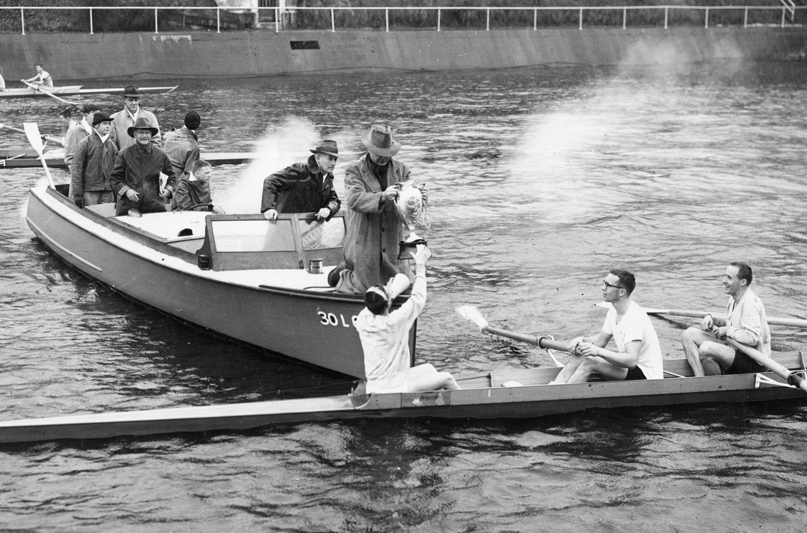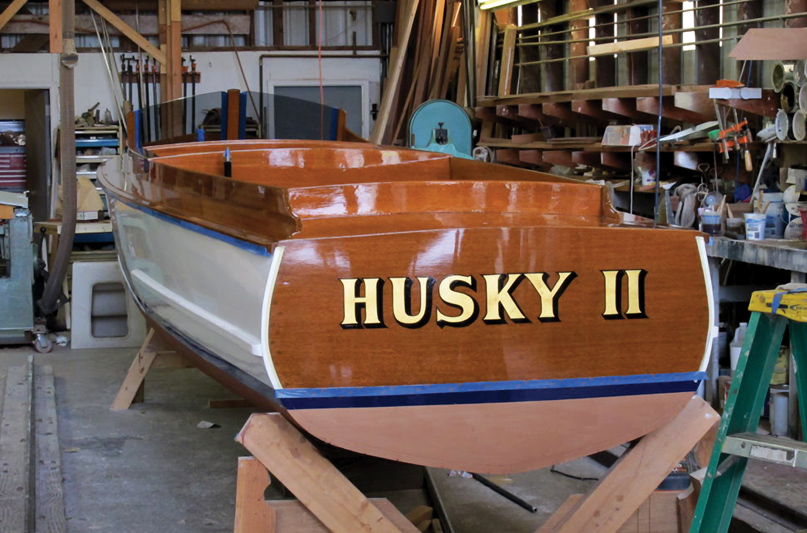
the Boys in the Boat were restored to their vintage glory.
 Every Seattle boater knows that Opening Day kicks off with crew races through the Montlake Cut, but not every boater appreciates how the University of Washington crew program impacted the development of Seattle, and even fewer will know the significance of two classic wooden motor boats that trail closely behind the racing crews.
Every Seattle boater knows that Opening Day kicks off with crew races through the Montlake Cut, but not every boater appreciates how the University of Washington crew program impacted the development of Seattle, and even fewer will know the significance of two classic wooden motor boats that trail closely behind the racing crews.
These classic boats—Husky II and Conny—are the original launches used by the legendary coaches of the crew teams that proved Seattle was more than a last pit stop for dreamers headed north. The Conny is the launch that guided the underdog team who won gold in the 1936 Olympics right under the nose of Hitler. Their story is told in the best-selling book Boys in the Boat. The Husky II is modeled after the Conny and the namesake of a launch that served the UW during the same golden era. Both boats were almost lost to neglect but eventually saved and given an honored place on today’s team; a championship team that is so intrinsic to what Seattle is today.
In 1899, the second year of the Klondike Gold Rush, Seattle was growing rapidly for a town that largely lacked indoor plumbing barely a decade earlier. The University of Washington had moved a few years earlier to its present location, and their access to water made the university a prime candidate for a crew team. E.F. Blaine, a local businessman and East Coast native, offered to raise money for the construction of a rowing shell. Two four-man training gigs were built, and the different classes raced amongst themselves.
It wasn’t until 1903 that the first intercollegiate crew race on the West Coast took place in Seattle, held between UW and the University of California. Locals wanted to legitimize Seattle as a city and saw the race as a sporting event to rival the baseball stadiums of older, more established cities. From its inception, the race was a hit, attracting thousands of spectators.
“You have to ask yourself what other spectator sporting events were going on in Seattle in 1903,” said Eric Cohen, University of Washington rowing historian. “The answer is not much, so yes, the races were a big draw right from the beginning.”

Seattle, the University of Washington, and the crew program all continued to grow. In 1906, Hiram Conibear became the head coach of the program. Conibear developed the “Conibear Stroke” during his tenure, a new way of rowing the shell, which would become the American standard. Conibear’s other major contribution to UW crew was convincing boat builder George Pocock to move to Seattle.
Pocock’s racing shells were revolutionary for their time, and he would eventually supply shells to every crew program in the country. Although Conibear died in an accident in 1917, his legacy, which included taking Washington to their first Intercollegiate Rowing Association (IRA) National Championship Regatta, was beyond solidified. “I can say without a doubt in my mind that Hiram Conibear is the most influential coach in the history of the program,” said Cohen.
Other coaches came after Conibear, and the team went to the national championships for the first time in eight years in 1922. The Seattlites were still regarded as underdogs, denizens of a backwater town in the middle of nowhere. But they quickly earned the respect of the centuries-old East Coast schools, coming in a close second behind Navy, with the rest of the field far behind. If Washington had earned a half measure of respect in 1922, they would get their full share in 1923 when Coach Rusty Callow lead them to their first national championship.
The returning team was greeted in Seattle with a parade and Coach Callow was given the key to the city in recognition of Seattle’s first major sport victory on a national stage. The Huskies remained competitive through the rest of the 1920s, although they came in third in 1928, the first year that Al Ulbrickson served as head coach. Ulbrickson would eventually start a winning streak that would culminate in a gold medal win at the 1936 Berlin Olympics.
From the beginning of his tenure as head coach, Ulbrickson joined his athletes on the water every crisp morning of the training season on his own custom launch, the Conny, named for Hiram Conibear. From his office over the water, Ulbrickson could critique his athletes and make adjustments as needed. Pocock, the visionary boatmaker, would often join Ulbrickson and offer his own advice to the team.
The 1936 team became champions, coached by Ulbrickson yelling over a megaphone from the Conny. Custom-built by Shertzer Brothers on Lake Union, the Conny needed a special design to serve as a coach’s launch; she needed to be big, to hold nine men in case a racing shell capsized, and a round bottom to minimize wake.

After serving faithfully for all Ulbrickson’s career and beyond, the Conny was taken out of commission one evening in 1971. She was struck broadside after two crew members took their dates out for a night on the water. The Conny was in multiple pieces, but her historical significance to the Ulbrickson era of the crew program was not yet recognized.
After sitting in a University of Washington storage yard for several years, the Conny caught the eye of team manager Kirk “Lucky” Knapp.
“When I saw Conny in the storage yard my junior year, I came back and tried to get Dick (Erickson, head rowing coach at Washington from 1968-1987) interested. But he had a fully functioning launch. He kept telling me to go pick it up if I wanted it, and finally, in 1978, I was able to do that,” said Knapp in an interview with Eric Cohen.
Although the Conny had been rescued from the UW storage yard, it wasn’t until 1996 that Knapp had the time and money to give her the attention she deserved. Knapp contacted and handed the pieces of the boat off to Dave Berg. Fortune seems to have favored her restoration, as an unlikely find from 150 miles away reunited the Conny with her original engine.
The Conny’s original Scripps F-6 engine was replaced in the ‘50s or ‘60s by a Chrysler Crown. That replacement engine was long gone, but Knapp heard from Curt Erickson that he had acquired an ancient Scripps F-6, said to be from a rowing launch. Separated by miles, Knapp measured the mounting holes on the Conny and Erikson measured the same on the engine. Initially, they were disappointed to find the numbers didn’t match, until they realized that they were measuring from different directions.
“That was the moment we knew we had it right. That engine – sitting 150 miles away and salvaged by fortune – was the original. We got it up to Bellingham and it fit into the engine bed perfectly. That was a great day,” said Knapp. Dave Berg continued to work on the Conny for two years in his shop before she was ready to be launched on August 12, 1998.
The first custom-made boat delivered to the Washington rowing program was the Husky: a 36’ launch delivered to the university in 1923. Through the ‘20s and ‘30s, the Husky and the Conny worked side by side, but the aging Husky was replaced in the ‘40s by the Husky II, a boat designed to the same specifications as the Conny. The fate of the first Husky remains a mystery. Her replacement, the Husky II was on the water everyday throughout the ‘40s, ‘50s, and ‘60s, but by the 1970s she was spending her days languishing in the launch house.

When Bob Ernst was hired by UW as the men’s freshman coach in 1974, the university offered him a ski boat as a launch, but it put up a huge wake. Ernest noticed the Husky II sitting in the launch house. “Bob Ernst was interested in the history of the program from the beginning, and was the first to recognize the Husky II as significant to the team,” said Cohen. Told no one else used the boat, Ernst had her tuned up and she became the freshman launch.
By the 1990s, the Husky II was seeing less action once again and starting to show her age. Ernst reached out to Chris Eden, president of the Northwest Classic Boat Club. Eden connected him to Greg Harrison and a boat restoration vocation program at Seattle Central Community College. The students worked on the Husky II for several years, and she was relaunched in 2002. The historic launch was now finally recognized as a link to the program’s rich past, but her revival was not over yet. By 2010 the boat was leaking again, and the bottom planks needed to be replaced. Blake Nordstrom of the Washington Rowing Stewards understood the value of the Husky II to the program and the university. He reached out to Brooke Larsson of Larsson Marine to see what he could do.
“We went down and took a look. You could put your hand through the floorboards. That’s how bad it was,” said Larsson. Too delicate to move, the Husky II was loaded on to a piece of reinforced plastic and taken to Larsson’s shop in Portage Bay.
Larsson and his team stripped the Husky II down to the keel and replaced every plank. The keel itself was crooked and had to be straightened in a jig built on the dock. The helm had to look original, so gauges and a horn were found and re-plated. The Husky II was relaunched in 2014, and in 2017 at the 106th annual “Dual Race”, both she and the Conny were once again side by side, following behind the UW crew, echoing the past and reminding all of those who came before. Two living pieces of history finally recognized for their contribution to a team so deeply connected to local history.